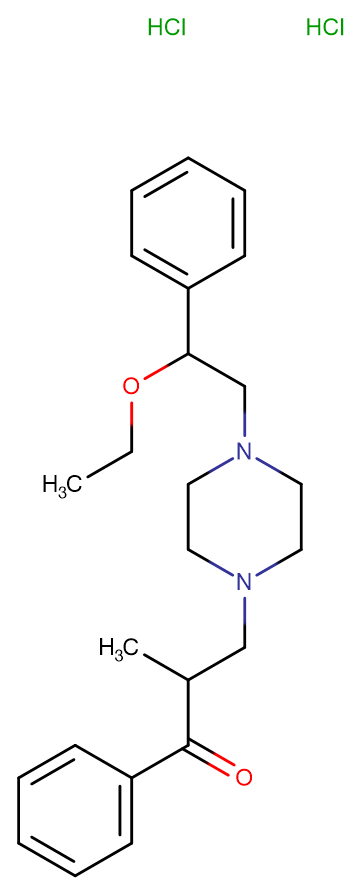
Eprazinone dihydrochloride
CAS No. 10402-53-6
Eprazinone dihydrochloride( —— )
Catalog No. M10205 CAS No. 10402-53-6
Eprazinone 2hydrochloride is a drug with proposed mucolytic, secretolytic, and bronchial antispasmodic properties.
Purity : >98% (HPLC)
 COA
COA
 Datasheet
Datasheet
 HNMR
HNMR
 HPLC
HPLC
 MSDS
MSDS
 Handing Instructions
Handing Instructions
| Size | Price / USD | Stock | Quantity |
| 50MG | 30 | Get Quote |


|
| 100MG | 49 | Get Quote |


|
| 500MG | 156 | Get Quote |


|
| 1G | Get Quote | Get Quote |


|
Biological Information
-
Product NameEprazinone dihydrochloride
-
NoteResearch use only, not for human use.
-
Brief DescriptionEprazinone 2hydrochloride is a drug with proposed mucolytic, secretolytic, and bronchial antispasmodic properties.
-
DescriptionEprazinone 2hydrochloride is a drug with proposed mucolytic, secretolytic, and bronchial antispasmodic properties.(In Vitro):Eprazinone specifically displaces binding to the NK1R. Although Eprazinone displays a rather weak inhibition of [125I]BH-SP binding to NK1R, at a concentration of 25 μM, and an antagonistic effect of about 30%, NK1R blockade could contribute to its mucolytic activity.(In Vivo):Eprazinone (50-200 mg/kg; oral gavage; daily; for 4 days; adult male rats) at a dose of 200 mg/kg significantly increases total and individual (with the exception of phosphatidylinositol) phospholipid levels and decreases total neutral lipids. Lower doses of Eprazinone significantly decrease neutral lipid levels without affecting the phospholipids.In airway epithelial studies, mucosal addition of Eprazinone produces a dose-dependent partially reversible decrease in short-circuit current (Isc). The decrease in Isc at lower Eprazinone concentrations is accounted for entirely by a decrease in net chloride secretion while at higher concentrations both sodium and chloride transport are affected.
-
In VitroEprazinone specifically displaces binding to the NK1R. Although Eprazinone displays a rather weak inhibition of [125I]BH-SP binding to NK1R, at a concentration of 25 μM, and an antagonistic effect of about 30%, NK1R blockade could contribute to its mucolytic activity.
-
In VivoEprazinone (50-200 mg/kg; oral gavage; daily; for 4 days; adult male rats) at a dose of 200 mg/kg significantly increases total and individual (with the exception of phosphatidylinositol) phospholipid levels and decreases total neutral lipids. Lower doses of Eprazinone significantly decrease neutral lipid levels without affecting the phospholipids.In airway epithelial studies, mucosal addition of Eprazinone produces a dose-dependent partially reversible decrease in short-circuit current (Isc). The decrease in Isc at lower Eprazinone concentrations is accounted for entirely by a decrease in net chloride secretion while at higher concentrations both sodium and chloride transport are affected. Animal Model:Adult male pathogen free Fischer 344 inbred rats (200-250 g) Dosage:50 mg/kg, 100 mg/kg, and 200 mg/kg Administration:Oral gavage; daily; for 4 days Result:At a dose of 200 mg/kg significantly increased total and individual (with the exception of phosphatidylinositol) phospholipid levels and decreased total neutral lipids.
-
Synonyms——
-
PathwayOthers
-
TargetOther Targets
-
RecptorOthers
-
Research AreaOther Indications
-
Indication——
Chemical Information
-
CAS Number10402-53-6
-
Formula Weight453.44
-
Molecular FormulaC24H32N2O2·2HCl
-
Purity>98% (HPLC)
-
SolubilityWater: 18 mg/mL (39.69 mM); DMSO: 1 mg/mL (2.2 mM)
-
SMILESCl.Cl.CCOC(CN1CCN(CC(C)C(=O)C2=CC=CC=C2)CC1)C1=CC=CC=C1
-
Chemical Name——
Shipping & Storage Information
-
Storage(-20℃)
-
ShippingWith Ice Pack
-
Stability≥ 2 years
Reference
1.Thrall RS, et al. Exp Lung Res, 1992, 18(3), 409-420.
molnova catalog



related products
-
Alpha-calcium ketogl...
Alpha-calcium ketoglutarate monohydrate is the calcium salt form of Alpha-ketoglutarate, which is involved in the tricarboxylic acid cycle in organisms.
-
CDK2
CDK2 is a member of the eukaryotic S/T protein kinase family and its function is to catalyze the phosphoryl transfer of ATP γ-phosphate to serine or threonine hydroxyl (denoted as S0/T0) in a protein substrate.
-
2R,4S-Sacubitril
2R,4S-Sacubitril is the impurity of Sacubitril which is a neprilysin inhibitor.



 Cart
Cart
 sales@molnova.com
sales@molnova.com


